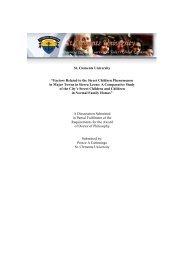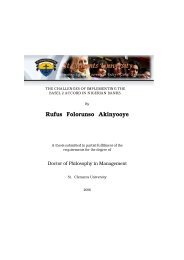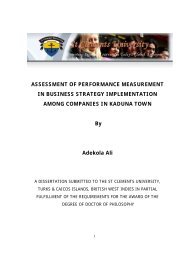The role of informal microfinance institutions in saving
The role of informal microfinance institutions in saving
The role of informal microfinance institutions in saving
You also want an ePaper? Increase the reach of your titles
YUMPU automatically turns print PDFs into web optimized ePapers that Google loves.
3.1 .1: Data Type<br />
<strong>The</strong> study used ma<strong>in</strong>ly primary and secondary data from <strong>in</strong>dividual entrepreneurs and farmers<br />
receiv<strong>in</strong>g credit from both formal and <strong><strong>in</strong>formal</strong> credit <strong><strong>in</strong>stitutions</strong> as well as those who did not.<br />
<strong>The</strong> formal f<strong>in</strong>ancial <strong><strong>in</strong>stitutions</strong> considered <strong>in</strong> this study were commercial banks, non-bank<br />
f<strong>in</strong>ancial <strong><strong>in</strong>stitutions</strong>, sav<strong>in</strong>gs and credit cooperative societies (SACCOs). Informal f<strong>in</strong>ance as<br />
researcher said earlier that has been used to refer to all transactions, loans and deposits<br />
occurr<strong>in</strong>g outside the regulation <strong>of</strong> a central monetary or f<strong>in</strong>ancial market authority (Adams<br />
and Von Pischke, 1992; Aryeetey and Udry, 1997). <strong>The</strong> <strong><strong>in</strong>formal</strong> f<strong>in</strong>ancial <strong><strong>in</strong>stitutions</strong> <strong>in</strong> this<br />
study consisted <strong>of</strong> rotat<strong>in</strong>g sav<strong>in</strong>gs and credit associations (ROSCAs), sav<strong>in</strong>gs and credit<br />
associations (SACAs), mutual assistance groups(MAGs), relatives and friends, welfare<br />
associations, community -based organizations and non government organizations(NGOs). <strong>The</strong><br />
primary data were collected by adm<strong>in</strong>ister<strong>in</strong>g structured questionnaires to the sampled<br />
respondents.<br />
3.1.2: Research Design<br />
In plann<strong>in</strong>g for the research study, the researcher was m<strong>in</strong>dful <strong>of</strong> the need to have a well<br />
articulated research design. Such a research design is desirable for the objective <strong>of</strong> data<br />
collection that will be useful <strong>in</strong> address<strong>in</strong>g the research questions as well as test the stated<br />
hypothesis. It is therefore a veritable guide for data generation, especially primary data. <strong>The</strong><br />
research strategy adopted <strong>in</strong> this study is the survey technique. This strategy was chosen<br />
because <strong>of</strong> the nature <strong>of</strong> the research topic which demands the collection <strong>of</strong> significant amount<br />
<strong>of</strong> data from a mean<strong>in</strong>gful population size <strong>in</strong> an efficient manner. Because this method is well<br />
understood and perceived as authoritative by people <strong>in</strong> general, it was most appropriate for<br />
its adoption.<br />
<strong>The</strong> research study was both exploratory and formal. <strong>The</strong> study was exploratory because it has<br />
the objective <strong>of</strong> discover<strong>in</strong>g future research tasks. It was equally formal because it further<br />
extends the exploratory work by test<strong>in</strong>g the hypotheses designed and also answers the<br />
research questions asked. <strong>The</strong> research tries to f<strong>in</strong>d out what support measures were given to<br />
SACCOs and by whom, which made it a descriptive study <strong>in</strong> one hand. On the other hand,<br />
the study was causal <strong>in</strong> the sense that attempt was made to f<strong>in</strong>d out the causal relationships<br />
154
















